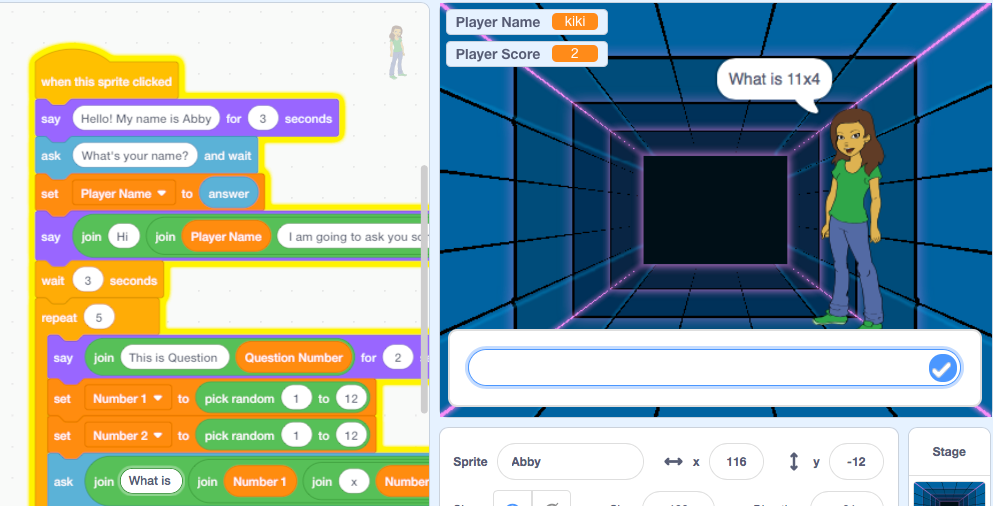By Ashley Lovnicki and Meghan Monaghan, Pre-service teachers, Brock University with Chantal Buteau, Brock University
On Thursday May 2nd, 2019, the Department of Mathematics and Statistics at Brock University continued on its collaboration with the Niagara Catholic District School Board (NCDSB). In the upcoming school year, preservice teachers completing their undergraduate studies at Brock University will work with ten teachers in the classroom. Together, the preservice and classroom teachers will develop and implement engaging and interactive mathematics lessons and activities wherein computer programming are incorporated.
During the gathering on May 2nd, teachers from NCDSB made the connection between mathematics and coding through various block-based coding activities which included using Scratch and programming Dash-The-Robot in Blockly. This learning session, at which some Brock pre-service teachers also attended, allowed teachers to demystify computational thinking and what it could look like in their classrooms by actively engaging in mathematical coding activities. Some of these activities are available through Math Knowledge Network (MKN) resources. By completing the activities, the classroom teachers were able to experience for themselves the benefits of integrating coding for mathematics learning.
One activity that was used to introduce the teachers to coding was to program Dash to move around a set of three squares. This activity was mathematical as it involved applying our knowledge of what a square is. This meant they had to have Dash move a certain distance, rotate 90 degrees, then move the same distance and repeat these steps multiple times until Dash had walked the entire square. The challenge was that each of the three squares were different sizes, but as a coder, you want to be efficient and optimize code as much as possible. This sparked great discussions about variables, how to have the variable change, and where certain blocks of code should go in order to have efficient code. In the end, the optimized code was input and Dash successfully walked all three squares. Our follow-up discussion and reflection highlighted how mathematical our engagement was: the use of a variable, the problem-solving skills of breaking down the problem (walking the 3 squares) into smaller ones (walking one square), the necessity of measurements, and the logic required to properly sequence the commands.
Other activities included coding in Scratch by exploring patterning and angles through a ScratchMaths activity [1] and by computationally modeling an evolving situation through a story [2].

It didn’t end there. We met again on May 14 for half-a-day to explore different kinds of tasks integrating coding in Scratch and mathematics: learning by creating an interactive math story and by creating a math game. For example, pairs of teachers coded a game to practice times table using randomly generated questions. There were many diverse designs for the game (the rooster was cock-a-doodle-dooing or the little girl was cheering) but one common observation: all were completely immersed in working out the mathematics of coding their game! Teachers left the session with a little homework: What kind of coding+math tasks would they like to design and implement in their classroom next year in collaboration with pre-service teacher partners?

The aim of this collaboration is for preservice teachers to practice the skills that they learn in the mathematics department at Brock University and implement computer coding principles and computational thinking into the classroom. For current teachers in the classroom, this collaboration is a unique opportunity of seeing different ways that mathematics and coding can be integrated into their classrooms. This collaboration is part of a required course for preservice teachers’ undergraduate degrees here at Brock University. Previously, five preservice teachers worked in classrooms ranging from grade 2 to grade 9 and developed lessons and activities using technology such as Scratch, Dash robot, and a CNC machine[3]. In the 2019-2020 school year, this will be the second offering of the course integrating a collaboration with the 10 teachers from NCDSB.
[1] ScratchMaths is a two-year computing and mathematics-based curriculum for pupils in Grades 5 and 6 in England. Its aim is to enable pupils to engage with and explore important mathematical ideas through learning to program. See https://www.ucl.ac.uk/ioe/research/projects/scratchmaths for free online complete material.
[2] Two stories were selected: Anno’s Magic Seed at http://researchideas.ca/seeds/, and Bhanu and the chocolate cupcake to be published soon in OAME Gazette journal.
[3] http://mkn-rcm.ca/brock-u-ncdsb-ct-math-tasks/
